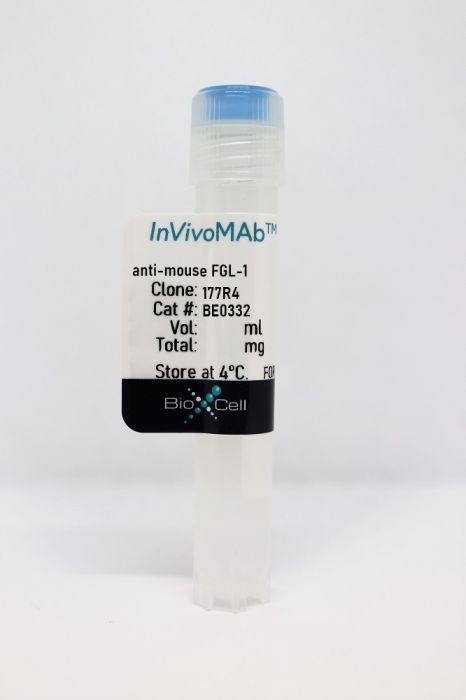InVivoMAb anti-mouse FGL-1
Product Details
The 177R4 monoclonal antibody reacts with mouse Fibrinogen-like protein 1 (FGL-1). FGL-1 is a member of the fibrinogen family of proteins. Under normal physiological conditions, FGL-1 is primarily secreted from hepatocytes and contributes to mitogenic and metabolic functions. FGL-1 is produced at high levels in various tumors including lung cancer and melanoma. High FGL-1 expression is associated with resistance to anti-PD-1/PD-L1 therapy and poor prognosis of cancer patients. Recently, FGL-1 has been identified as a major inhibitory ligand for LAG-3, a receptor that negatively regulates the proliferation, activation, and effector function of T cells. In murine cancer models, the 177R4 clone has been shown to block FGL-1 binding to LAG-3 resulting in boosted T cell activity and slowed tumor growth.Specifications
| Isotype | Rat IgG2a, κ |
|---|---|
| Recommended Isotype Control(s) | InVivoMAb rat IgG2a isotype control, anti-trinitrophenol |
| Recommended Dilution Buffer | InVivoPure pH 7.0 Dilution Buffer |
| Conjugation | This product is unconjugated. Conjugation is available via our Antibody Conjugation Services. |
| Immunogen | Murine FGL-1-Ig fusion protein |
| Reported Applications |
in vivo FGL-1 blockade in vitro FGL-1 blockade Flow cytometry Immunohistochemistry (paraffin) |
| Formulation |
PBS, pH 7.0 Contains no stabilizers or preservatives |
| Endotoxin |
<2EU/mg (<0.002EU/μg) Determined by LAL gel clotting assay |
| Purity |
>95% Determined by SDS-PAGE |
| Sterility | 0.2 µm filtration |
| Production | Purified from cell culture supernatant in an animal-free facility |
| Purification | Protein G |
| RRID | AB_2894752 |
| Molecular Weight | 150 kDa |
| Storage | The antibody solution should be stored at the stock concentration at 4°C. Do not freeze. |
Recommended Products
in vivo FGL-1 blockade, in vitro FGL-1 blockade, Flow Cytometry, Immunohistochemistry (paraffin)
Wang, J., et al. (2019). "Fibrinogen-like Protein 1 Is a Major Immune Inhibitory Ligand of LAG-3" Cell 176(1-2): 334-347 e312. PubMed
Lymphocyte-activation gene 3 (LAG-3) is an immune inhibitory receptor, with major histocompatibility complex class II (MHC-II) as a canonical ligand. However, it remains controversial whether MHC-II is solely responsible for the inhibitory function of LAG-3. Here, we demonstrate that fibrinogen-like protein 1 (FGL1), a liver-secreted protein, is a major LAG-3 functional ligand independent from MHC-II. FGL1 inhibits antigen-specific T cell activation, and ablation of FGL1 in mice promotes T cell immunity. Blockade of the FGL1-LAG-3 interaction by monoclonal antibodies stimulates tumor immunity and is therapeutic against established mouse tumors in a receptor-ligand inter-dependent manner. FGL1 is highly produced by human cancer cells, and elevated FGL1 in the plasma of cancer patients is associated with a poor prognosis and resistance to anti-PD-1/B7-H1 therapy. Our findings reveal an immune evasion mechanism and have implications for the design of cancer immunotherapy.
- Cancer Research,
- Genetics
ALKBH5 enhances efficiency of anti-PD-1/PD-L1 therapy by reducing Lnc-XIST/miRNA- 124-3p mediated FGL1 expression in bladder cancer
Preprint on Research Square on 11 October 2022 by Xia, Y., Jiang, X., et al.
Background: Fibrinogen-like 1 (FGL1), the promising inhibitory immune checkpoint, has been proved to promote immune escape and abrogate the efficacy of immunotherapy in malignancy. However, knowledge on its dynamic expression and regulatory mechanism in course of cancer immunotherapy is limited in bladder cancer (BCa). The vital roles of N6‑methyladenosine (m6A) RNA methylation have been identified in multiple biological activities, including tumor immunity. However, the roles of m6A modification on FGL1 expression and anti-tumor immunity are unknown. Methods The associations of dynamic FGL1 expression with immunotherapy, tumor-infiltrated immune cells and prognosis in BCa patients were assessed in public datasets, vitro and vivo tumor models. Furthermore, a siRNAs kit targeting m6A related genes were utilized and identified that ALKBH5 regulated the expression of FGL1. Moreover, methylated RNA immunoprecipitation (Me‑RIP), RT‑qPCR and rescue experiments were performed to validate the molecular mechanism underlying ALKBH5/Lnc-XIST axis in FGL1 expression. And the luciferase report assays were carried out to identify the sponge of Lnc-XIST with miR-124-3p and interactions between miR-124-3p and FGL1 and PD-L1. The xenograft tumor mice models were constructed to verify the anti-tumor effects of single or combined ICIs in BCa with aberrant expressions of FGL1 and ALKBH5. Results In this study, we found that high expression level of FGL1 was associated with poor immunotherapy response and prognosis in BCa. Functionally, elevated FGL1 expression reducing tumor-infiltrated CD8 + T cells and abrogated anti-tumor immunity in an immunocompetent mouse model. Furthermore, ALKBH5 knockdown significantly promoted FGL1 expression via up-regulating Lnc-XIST expression in an m6A dependent manner. Lnc-XIST was found to act as a ceRNA by sponging miR-124-3p which reversed up-regulation of FGL1 induced by ALKBH5. Further analysis identified that PD-L1 was also a downstream target of miR-124-3p in BCa. In addition, co-blockade of FGL1/LAG3 and PD-L1/PD-1 axis motivated more effective antitumor immune response in BCa with low ALKBH5 expressions. Conclusion Our study suggested that ALKBH5 regulated FGL1 expression via Lnc-XIST/ miR-124-3p axis in an m6A dependent manner and dual blockade of FGL1/LAG3 and PD-L1/PD-1 axis could significantly inhibit tumor growth in BCa with low-ALKBH5 expressions. These results will provide implications for precise and efficient therapeutic strategies in the BCa immunotherapy.



